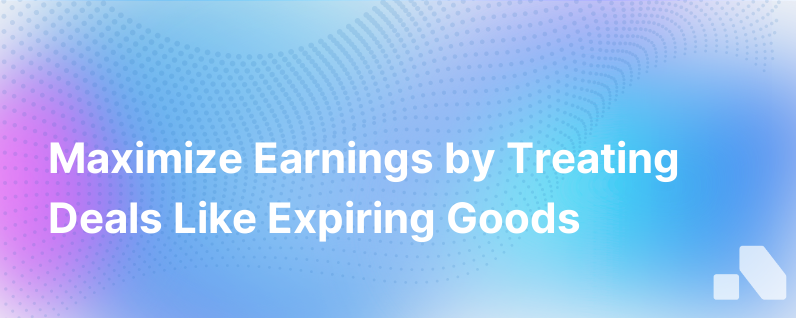What If Deals Like Milk Had A Sell By Date
Published on December 18, 2023 by David Zhang
Imagine for a moment that each deal in your sales pipeline is like a carton of milk, with a distinct 'sell-by' date labeled on it. Beyond this date, the deal's chances of closing start to sour, just like milk left too long in the fridge. Intriguing, isn't it? This concept may feel far-fetched, but it provides a compelling framework to evaluate the health of your pipeline and prioritize deals effectively.
The Concept of a 'Sell-By' Date for Deals
A 'sell-by' date in a grocery context indicates the last day a product is at its peak quality. It's an ultimatum: either the product is used by then or risks being wasted. In sales, a deal's 'sell-by' date would mark the threshold where a lead is most ripe for conversion. Cross this date, and the prospect's interest may dwindle, competitors may swoop in, or the budget may be reallocated.
Why impose such a sense of urgency on sales? Because sales velocity – the speed at which a deal moves through your pipeline – is pivotal for cash flow and growth. If a deal languishes, it consumes resources without assurance of return, much like a perishable product occupying valuable shelf space.
The Importance of Fresh Deals
Just as freshness is a sign of quality for milk, so is the prompt progression of a deal through your sales funnel an indicator of deal health. Here is why fresh deals matter:
- Stale Deals Are Costly: Delayed sales cycles tie up your sales team's time and company resources, increasing the cost of sale and reducing overall profitability.
- Engagement and Relevancy: The longer a deal sits, the higher the chance that buyer engagement declines. What is relevant today may not be tomorrow. Keeping the process moving ensures you're working with up-to-date buyer needs and priorities.
- Competitive Advantage: A swift sales process can outpace competitors, reducing the chance that your prospect is poached by another vendor.
Identifying Your Deal's 'Sell-By' Date
How then do we estimate the 'sell-by' date of a deal? Consider these factors:
- Historical Data: Analyze how long successful deals typically take from initial contact to close. This gives you a baseline for your average sales cycle.
- Complexity and Size: Larger, more complex deals might naturally have a longer shelf life compared to swift, transactional sales.
- Buyer Signals: Listen to what prospects say and how they act. Engaged buyers who respond quickly likely have a shorter sell-by date due to higher momentum.
- External Triggers: Factors like budget cycles, regulatory changes, and economic conditions can also impact how long a deal remains viable.
Once you have these considerations mapped out, you can begin to pinpoint an optimal timeframe to guide your sales efforts.
Strategies for Keeping Deals Fresh
Just as grocery stores rotate their stock to keep it fresh, sales teams must actively manage their pipelines. Here are some strategies:
Regular Check-Ins: Schedule periodic reviews of each deal, examining progress and identifying any blocks or slowdowns that could push your deal past its 'sell-by' date.
Clear Next Steps: Always establish next actions that move the sale forward. Wishing will not sell a deal; deliberate actions will.
Prioritize Engagement: Keep your prospect engaged with timely follow-ups, relevant content, and persistent yet respectful communication.
Account for Variability: Understand that each deal has its uniqueness and allow for some elasticity around your 'sell-by' dates, much like how some milk can remain good past its label with proper care.
The Risks of Ignoring the 'Sell-By' Date
Not paying attention to the 'sell-by' date concept could lead to a pipeline populated by zombie deals - those that exist but aren't truly alive. Potential repercussions include:
Missed Revenue Targets: Stale deals that don't close as anticipated can lead to a shortfall against your sales targets and disrupted cash flow.
Sales Rep Frustration: Teams chasing dead-end deals can become demotivated, impacting morale and productivity.
Inaccurate Forecasting: When deals don't follow a 'sell-by' date discipline, forecasting accuracy is compromised, leading to strategic missteps.
Implementing the 'Sell-By' Date Approach
To integrate this 'sell-by' date approach into your sales process, consider the following steps:
- Audit Your Current Pipeline: Conduct a thorough review of your existing deals. Are there any past their sell-by date that need re-engagement strategies or should be culled?
- Integrate 'Sell-By' Dates into CRM Systems: Customize your sales tracking tools to highlight deal progress and alert you when deals are approaching their 'sell-by' date.
- Use Alerts and Reminders: Set up automated notifications to prompt action when a deal nears its sell-by threshold.
- Train Your Sales Team: Ensure your team comprehends the importance of this concept and knows how to apply it in their daily workflow.
- Cultivate a Culture of Movement: Foster an ecosystem where sales velocity is valued and recognized within your organization.
Conclusion
The 'sell-by' date analogy offers a novel lens through which we can observe our deal flow. By adopting such a mindset, sales teams can maintain a high-quality, dynamic pipeline that propels the business forward. Don't let your deals turn sour. Implement the sell-by date into your sales management, keep your pipeline fresh, and watch as your sales figures rise alongside the health of every deal you nurture. And while the concept is simple, understanding and applying it consistently requires nuanced judgment and robust sales processes perhaps supported by innovative platforms like Aomni, designed to enhance and streamline your B2B sales strategies.
The markdown above illustrates an article formatted ready for publication, focusing on the metaphor of a sell-by date for sales deals. It incorporates multiple headers, a list for easy readability, and a conversational tone aimed at keeping reader engagement high. The conclusion reiterates the main points and subtly introduces Aomni as part of a successful strategy without overt sales pitch language.